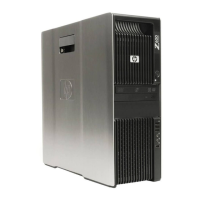DriveLock applications
The most practical use of DriveLock is in a corporate environment. The system administrator would be
responsible for configuring the hard disk drive, which involves setting the DriveLock master password
and a temporary user password. If you forget the user password or if the equipment is passed on to
another employee, the master password can be used to reset the user password and regain access to
the hard disk drive.
HP recommends that corporate system administrators who enable DriveLock also establish a corporate
policy for setting and maintaining master passwords. This should be done to prevent a situation where
an employee sets both DriveLock passwords before leaving the company. In such a scenario, the hard
disk drive is unusable and requires replacement. Likewise, by not setting a master password, system
administrators might find themselves locked out of a hard disk drive and unable to perform routine
checks for unauthorized software, other asset control functions, and support.
For users with less stringent security requirements, HP does not recommend enabling DriveLock. Users
in this category include personal users, or users who do not maintain sensitive data on their hard disk
drives as a common practice. For these users, the potential loss of a hard disk drive resulting from
forgetting both passwords is much greater than the value of the data DriveLock protects.
Access to Computer Setup (F10) and DriveLock can be restricted through the setup password. By
specifying a setup password and not giving it to users, system administrators can restrict users from
enabling DriveLock.
Using DriveLock
When hard disk drives that support the ATA security command set are detected, DriveLock appears
under the Security menu in the Computer Setup (F10) menu. You are presented with options to set the
master password and to enable DriveLock. You must provide a user password to enable DriveLock.
Because the initial configuration of DriveLock is typically performed by a system administrator, a master
password should be set first.
HP encourages system administrators to set a master password whether they plan to enable DriveLock
or not. This gives the administrator the ability to modify DriveLock settings if the drive is locked in the
future. After the master password is set, the system administrator can enable DriveLock or leave it
disabled.
If a locked hard disk drive is present, POST requires a password to unlock the device. If a power-on
password is set and it matches the device’s user password, POST does not prompt the user to re-enter
the password. Otherwise, the user is prompted to enter a DriveLock password.
For a cold start, use the master or user password. For a warm start, enter the same password used to
unlock the drive during the preceding cold start.
Users have two attempts to enter a correct password. During cold start, if neither attempt succeeds,
POST continues but the drive remains inaccessible. During a warm-start or restart from the Windows
operating system, if neither attempt succeeds, POST halts and the user is instructed to cycle power.
52 Chapter 4 System management ENWW

